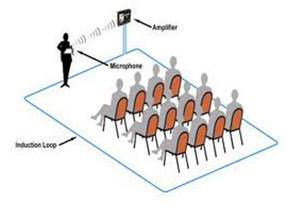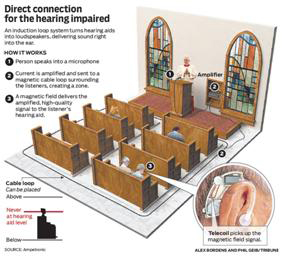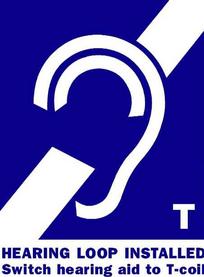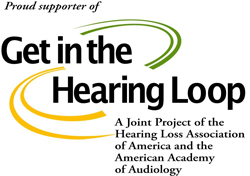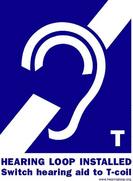Long Island (516) 731-5868
New York City (718) 641-3817
Commercial Loops
What Is An Induction Loop?
In its simplest form, an Induction Loop consists of a copper wire which is installed around the perimeter of a room. The copper wire is connected to the Induction Loop amplifier which is fed with a signal from the venue’s public address system, sound system or microphone. The loop amplifier drives an audio current (not an electric current) through the loop which then generates a magnetic field in the area enclosed by the copper wire. Therefore, any hearing device (hearing aid or cochlear implant) properly set to its T-coil setting will receive the signal.
Why Should You Loop?
On March 15, 2012, the revised ADA regulation which mandates that places of public assembly provide assistive listening devices became effective. In addition, Title III of the ADA requires all businesses and agencies, both profit and non-profit, to provide auxiliary aids and services to the hearing impaired population. (click here for more information). The three primary types of assistive devices which are accepted are FM Systems, Infrared Systems and Induction Loop Systems. The only system that is universal and compatible with all hearing aids that have a
T-coil is the Induction or Hearing Loop. FM Systems and Infrared Systems are usually manufacturer specific which means that the system is not always compatible with all hearing aids. Hence, these systems do not meet the needs of all hearing impaired individuals. The Induction Loop will provide assistance to all hearing impaired individuals who are using a hearing device with a T-coil that is turned on. The Induction Loop is cost effective, meets ADA requirements and assures better hearing for individuals with hearing loss. In addition, the Induction Loop is the preferred system because it eliminates hygienic concerns since there are no headsets involved.
Types of Induction Loops
One type of loop is a Conventional Loop. The loop is designed and installed so that the entire area is part of that magnetic field, thus providing adequate amplification or field strength across the venue. Venues such as houses of worship, auditoriums, theatres, and meeting rooms will require this type of loop.
Another type of loop is a Counter Loop or Portable Loop. For example, a loop installed at a pharmacy counter will have a microphone installed on the service side of the counter which transmits the voice signal to the T-coil of the customer’s hearing aid. A pad is installed under the pharmacy counter which contains the copper wire that sends the signal to the amplifier.
Our Team
Our team consists of Licensed Audiologists, Engineers and Certified Design & Installation experts. The goal of our commercial loop installers in NYC and on Long Island is to design, install and ensure that our AFILS (Audio Frequency Induction Loop System) meets or exceeds the current International Electrotechnical Commission (IEC) 60118-4 standard and is ADA compliant. Every loop system will be certified by our installation team and a Certificate of Conformity will be provided once the system is officially finalized. In addition, we ensure that every system will continue to meet IEC standards by providing routine calibration and service of the Induction Loop System
Advantages of Commercial Induction Loops
Long term cost is minimized because of low system maintenance.
Loop systems will be used more frequently since the system operates in conjunction with the hearing device’s T-coil, thus, eliminating individual stigma of having to request and return visible assistive listening units such as headsets.
The number of required portable receiver units is reduced when using a looped system.
Hygienic concerns are eliminated.
Loops operate on a universal frequency which is received by any T-coil device.
Our Services Include
Comprehensive site survey of the intended venue at no additional cost which includes measurements, photographs and observation of the installation site
A design plan for the proposed installation
A quote that includes equipment type and cost, design and installation fees, initial calibration of system to meet IEC 60118-4 standard and provide Certificate of Conformity.
Arrange any sub-contracting services that may be required to complete the installation
Training on use of the loop system
Where Are Induction Loop Systems Installed?
This is a partial list of sites where hearing loops have been installed. The list of hearing loops in New York and in other areas of the United States is growing rapidly.
Houses of Worship
Theatres and Movies
Schools/Colleges/Universities
Funeral Homes
Restaurants
Museums
Stadiums
Train Stations
Airports
Pharmacies
Banks
Supermarkets
Auditoriums
Subway Ticket Booths
Senior Centers
Assisted Living Facilities
Meeting Rooms
Taxi Cabs
How Do You Know If A Venue Is Looped?
The sign must have a “T” in the lower right corner to be classified as induction loop signage
Please contact us to schedule your complimentary site survey. Our New York hearing loop team would be delighted to assist you in designing and installing an induction loop system in your venue.
For Induction Loop Installs in NY Call Us:
(718) 641-3817 in New York City
(516) 731-5868 on Long Island and Southern Connecticut
Acoustic Loop Innovations is a Proud Supporter of “Get in the Hearing Loop” a Joint Project of the Hearing Loss Association of America and the American Academy of Audiology
We are also members of the Manhattan Chapter of the Hearing Loss Association of America and proudly sit on their Looping committee
We invite you to join our group on Facebook - Click the blue link to join.
Long Island Loop Initiative (LILI) -
Our Group's Goal Is To Educate The Public About The Importance Of Hearing Access Through The Installation Of Induction Loops Throughout Long Island


